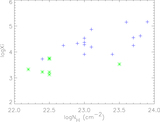Physical Conditions in Ultra-fast Outflows in AGN
Abstract
XMM-Newton and Suzaku spectra of Active Galactic Nuclei (AGN) have revealed highly ionized gas, in the form of absorption lines from H-like and He-like Fe. Some of these absorbers, ultra-fast outflows (UFOs), have radial velocities of up to 0.25c. We have undertaken a detailed photoionization study of high-ionization Fe absorbers, both UFOs and non-UFOs, in a sample of AGN observed by XMM-Newton. We find that the heating and cooling processes in UFOs are Compton-dominated, unlike the non-UFOs. Both types are characterized by force multipliers on the order of unity, which suggest that they cannot be radiatively accelerated in sub-Eddington AGN, unless they were much less ionized at their point of origin. However, such highly ionized gas can be accelerated via a magneto-hydrodynamic (MHD) wind. We explore this possibility by applying a cold MHD flow model to the UFO in the well-studied Seyfert galaxy, NGC 4151. We find that the UFO can be accelerated along magnetic streamlines anchored in the accretion disk. In the process, we have been able to constrain the magnetic field strength and the magnetic pressure in the UFO and have determined that the system is not in magnetic/gravitational equipartition. Open questions include the variability of the UFOs and the apparent lack of non-UFOs in UFO sources.
- Publication:
-
The Astrophysical Journal
- Pub Date:
- January 2018
- DOI:
- 10.3847/1538-4357/aa9ce0
- arXiv:
- arXiv:1711.07965
- Bibcode:
- 2018ApJ...852...35K
- Keywords:
-
- accretion;
- accretion disks;
- galaxies: active;
- X-rays: galaxies;
- Astrophysics - Astrophysics of Galaxies;
- Astrophysics - High Energy Astrophysical Phenomena
- E-Print:
- 18 pages, 9 figures. Accepted for publication in the Astrophysical Journal
